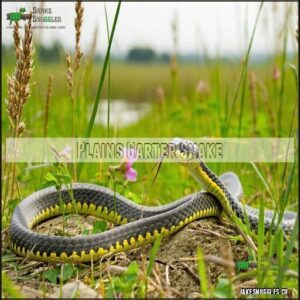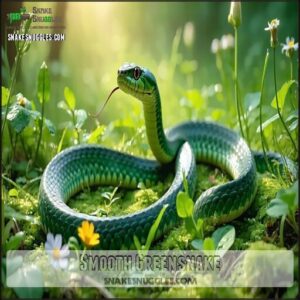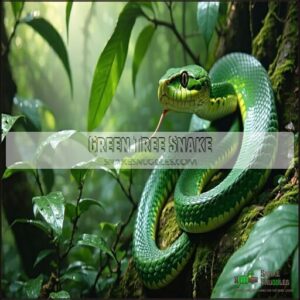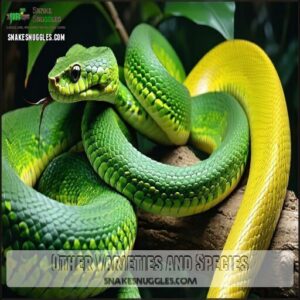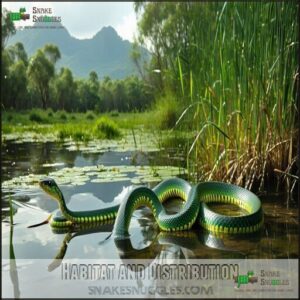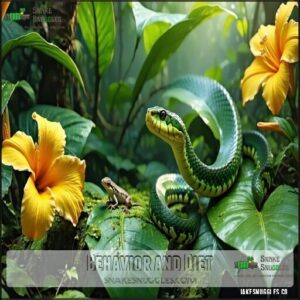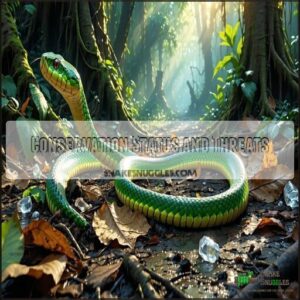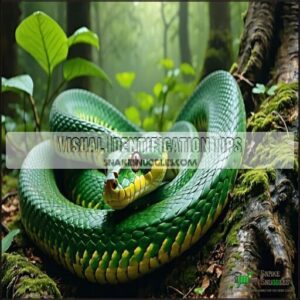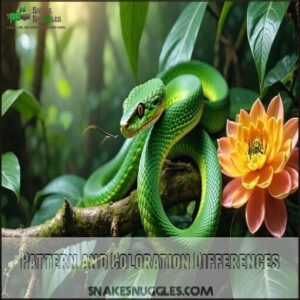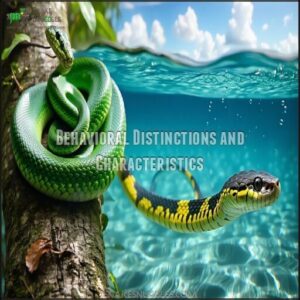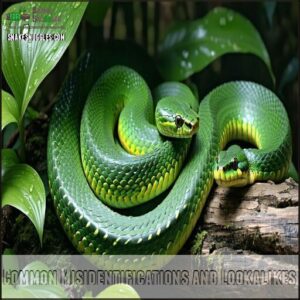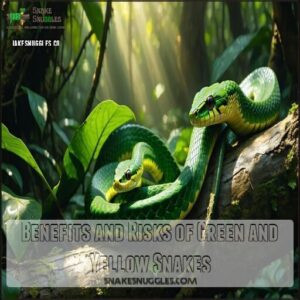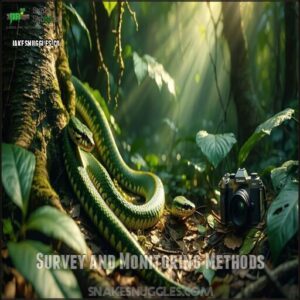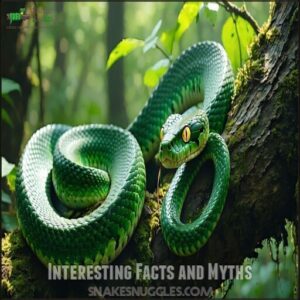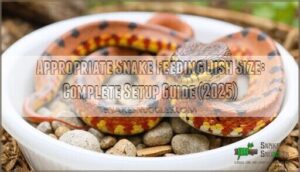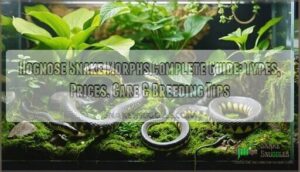This site is supported by our readers. We may earn a commission, at no cost to you, if you purchase through links.
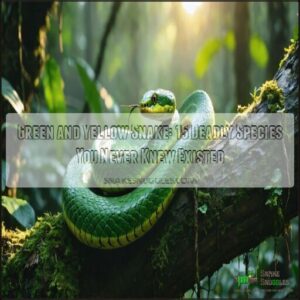 You’ll find green and yellow snakes in various species worldwide, from harmless garden visitors to deadly venomous serpents.
You’ll find green and yellow snakes in various species worldwide, from harmless garden visitors to deadly venomous serpents.
Their vibrant reptiles often use their striking coloration as a warning signal to predators. Common varieties include the Plains Garter Snake, Green Tree Python, and Eastern Rat Snake.
While some green and yellow snakes are completely harmless, others pack a punch that could send you to the hospital faster than you can say "snake charmer."
Their distinctive patterns help you identify whether you’re dealing with a friendly neighborhood reptile or one that deserves a wide berth. The difference might just save your life, as it is crucial to recognize the deadly venomous serpents and understand that some species are completely harmless.
Table Of Contents
- Key Takeaways
- Physical Characteristics
- Types of Green and Yellow Snakes
- Habitat and Distribution
- Behavior and Diet
- Conservation Status and Threats
- Identification and Distinction
- Benefits and Risks of Green and Yellow Snakes
- Survey and Monitoring Methods
- Interesting Facts and Myths
- Frequently Asked Questions (FAQs)
- What snakes are yellow?
- Do green snakes have yellow bellies?
- Are yellow snakes venomous?
- What does a yellow snake look like?
- Are green and yellow snakes dangerous?
- What color is a snake?
- What states have garter snakes?
- How many yellow & green snakes are there?
- What color are green snakes?
- What is a green & yellow snake?
- Conclusion
Key Takeaways
- You can identify green and yellow snakes by their distinct physical characteristics, including triangular heads for venomous species, scale patterns, and body shape – these visual cues are crucial for determining whether you’re dealing with a harmless garden visitor or a deadly serpent.
- While some green and yellow snakes like the Eastern Green Mamba are highly venomous and dangerous, others like the Smooth Greensnake and Rough Greensnake are completely harmless to humans and actually provide beneficial pest control in your garden.
- These snakes face significant conservation challenges due to habitat loss, pesticide exposure, and climate change, with several species now endangered or vulnerable – your awareness of their ecological importance can help protect these reptiles.
- You’ll find green and yellow snakes across diverse habitats worldwide, from forests and grasslands to urban areas, with each species displaying remarkable adaptations to their environment including specialized hunting behaviors, defensive mechanisms, and seasonal migration patterns.
Physical Characteristics
You’ll notice these deadly green and yellow snakes display distinctive physical traits, from bright emerald scales with yellow underbellies to triangular heads that signal their venomous potential.
Their bodies range dramatically in size, from the slender 12-inch Rough Green Snake to the imposing 8-foot Green Mamba that can deliver multiple rapid bites when threatened.
Color Patterns and Markings
Deadly green and yellow snakes showcase striking color patterns and markings that serve as essential survival mechanisms.
Their snake coloration demonstrates nature’s ingenious camouflage types across different species:
- Bright emerald bodies with vibrant yellow underbellies that blend perfectly with forest canopies
- Strategic longitudinal stripes that break up their silhouette when moving through grass
- Hypnotic diamond or zigzag bands providing disruptive camouflage against textured surfaces
- Scale iridescence that shifts colors depending on light conditions and viewing angles
- Pattern mimicry of more dangerous species, deterring potential predators
These color morphs aren’t just beautiful—they represent sophisticated evolutionary adaptations that vary by species and often display fascinating regional variations.
Body Shape and Size
While exploring the domain of green and yellow snakes, you’ll discover remarkable diversity in their body shapes and sizes.
These variations aren’t random but perfectly suited to each species’ survival strategy.
- Size Variation ranges from the pocket-sized 12-inch Rough Green Snake to the imposing 8-foot Green Mamba
- Sexual Dimorphism often means females grow larger than males
- Body Mass correlates with habitat—lighter snakes dominate tree canopies
- Scale Proportions differ between species, affecting flexibility and movement
Arboreal Adaptations typically produce slender, lightweight forms, while ground-dwellers develop more robust snake morphology to navigate their terrestrial environments, showcasing remarkable diversity in their body shapes and sizes.
Head Shape and Snout Structure
While body size gives you initial clues about a snake, head shape and snout structure are your best identification tools when spotting green and yellow species.
Head morphology varies substantially across different snake species. Venomous varieties typically feature triangular heads with distinct "necks," while non-venomous snakes show more uniform width from head to body.
| Snake Type | Head Shape | Snout Variation |
|---|---|---|
| Viper | Triangular | Broad, upturned |
| Green Mamba | Coffin-shaped | Elongated, pointed |
| Tree Python | Rectangular | Blunt, rounded |
Watch for facial pits near the nostrils—these heat-sensing organs appear in many venomous species, enabling precise strikes even in darkness. Scale arrangement around the head also provides critical identification markers. Some species, like copperheads, exhibit a distinct hourglass pattern on their bodies.
Scales and Skin Texture
Beneath the striking colors of green and yellow snakes lies an intricate system of scales that serves as their survival armor. These scales aren’t just decorative—they’re multifunctional shields with remarkable Scale Morphology that varies between species.
When you examine snake skin closely, you’ll notice Texture Variation that affects their movement and protection. Their scales provide:
- Specialized camouflage through Color Iridescence that reflects light differently based on viewing angle.
The Shedding Process reveals fresh scales underneath, essential for growth and healing. Each scale’s surface displays unique snake patterns that aid identification. Snake camouflage abilities depend on these scale arrangements, with smoother scales offering greater Tactile Sensitivity while rougher textures provide enhanced durability against harsh environments.
Types of Green and Yellow Snakes
You’ll encounter numerous green and yellow snake species worldwide, from the non-venomous Rough Green Snake with its slender bright green body to the deadly Eastern Green Mamba that delivers potent neurotoxic venom.
Each species has distinctive characteristics that help with identification, including specific scale patterns, head shapes, and habitat preferences that separate harmless garden visitors from their dangerous lookalikes.
Plains Garter Snake
The Plains Garter Snake’s distinctive yellow or orange stripe commands attention against its gray-green body.
The Plains Garter Snake flashes its vibrant yellow-orange racing stripe like nature’s caution tape against a subtle gray-green backdrop.
You’ll recognize this non-deadly species by its striking pattern and adaptable nature.
| Feature | Description | Note |
|---|---|---|
| Habitat | Prairies, wetlands, urban areas | Excellent at adapting to snake habitat |
| Size | 16-42 inches | Medium-sized reptile |
| Diet | Earthworms, amphibians, slugs | Natural pest control |
Though technically venomous, they’re harmless to humans.
Their Temperament remains docile unless threatened.
For Captive Care enthusiasts, these Morphs are low-maintenance compared to other snake species.
During winter, they hibernate underground in communal dens, emerging when temperatures rise.
Smooth Greensnake
Many wildlife enthusiasts are surprised to learn that the Smooth Greensnake (Opheodrys vernalis) contradicts this article’s "deadly" premise—it’s entirely nonvenomous and harmless to humans.
This slender, emerald-colored reptile with a yellowish-white belly thrives in meadows across eastern North America.
Four key facts about Smooth Greensnake behavior:
- Feeds exclusively on insects and spiders, making pest control its specialty
- Reproduces by laying 3-7 eggs during summer months
- Faces numerous predators including birds and larger snakes
- Currently experiencing concerning population decline due to habitat loss
Green Tree Snake
Moving from ground-dwelling snakes, the Australian Green Tree Snake reveals nature’s arboreal expertise. This non-venomous green snake, reaching up to 172cm, thrives in Australia’s rainforests and well-vegetated areas.
You’ll often spot these diurnal hunters near water sources, searching for frogs and small reptiles during daylight hours. When you approach them, they’ll inflate their bodies and release a distinctive odor—their primary defense mechanism.
Despite their name, they aren’t always green; some display blue or yellow colorations. These shaded habitat specialists make excellent natural pest controllers in your garden ecosystem, utilizing their diurnal habits to hunt for small reptiles.
Other Varieties and Species
Beyond green tree snakes, the world hosts numerous green and yellow snake varieties that might surprise you.
The vibrant world of snake species includes both harmless creatures and deadly predators. When considering snake identification, remember that color isn’t always a reliable indicator of danger.
Many species display fascinating color morphs and regional variations:
- Eastern Green Mamba showcases a brilliant emerald color with deadly neurotoxic venom that can be fatal
- Yellow Anacondas feature distinctive yellow-gold patterns with black markings, growing up to 15 feet long
- Eyelash Vipers come in stunning bright yellow or green forms with heat-sensing pits for perfect hunting
Some rare species like albino snakes lack pigmentation, appearing yellow when they’d normally be green. Hybrid snakes also exist, combining traits from different species and creating unique green and yellow snake patterns not commonly recognized.
Habitat and Distribution
You’ll find these deadly green and yellow snakes across six continents, from the Eastern Green Mamba in coastal Africa to the Tiger Snake in Australia’s wetlands.
They’ve adapted to diverse habitats including rainforests, grasslands, and even suburban areas where they hunt for prey and establish their territories.
Geographic Range and Native Regions
After exploring various snake species, let’s map their continental distribution across the globe.
Green and yellow snakes showcase remarkable regional variations in their native territories. You’ll find smooth greensnakes throughout the Nearctic region, spanning southeastern Canada to Virginia, with isolated populations in Wyoming, Colorado, and Utah. Rough greensnakes dominate Florida’s mainland and Keys.
The climate influence on snake distribution is striking – green tree pythons thrive in New Guinea, Indonesia, and Australia’s Cape York Peninsula, while eastern garter snakes extend from central Canada to Costa Rica. Understanding the snake’s original habitat is essential for conservation efforts. This snake habitat specificity helps with accurate green snake identification in the wild.
The table provides a comprehensive overview of the native territories and geographic hotspots for each species, including the smooth greensnake, rough greensnake, green tree python, grass snake, and plains garter snake. This information is crucial for wildlife conservation and snake identification.
Preferred Environments and Ecosystems
While ranging across continents, green and yellow snakes display remarkable habitat specificity in their chosen environments.
These reptiles thrive in distinct natural settings:
- Dense forests where their green coloration provides perfect camouflage among leaves and vines
- Grassland prairies where yellow-bellied species blend with sun-dappled terrain
- Wetland margins where moisture levels support their preferred prey species
Understanding their needs is key to successful snake keeping.
Their microhabitat preferences reflect millions of years of environmental adaptations, perfectly positioning them within their ecosystem roles.
Adaptation to Urban and Rural Areas
While natural areas remain their primary habitat, many green and yellow snake species have successfully adapted to human-altered landscapes. You’ll find these adaptable reptiles in surprising urban and rural settings.
- Eastern Green Mambas occasionally enter suburban gardens searching for rodents
- Yellow Rat Snakes thrive in farmland edges where rodent populations flourish
- Green Tree Pythons utilize urban parks with sufficient tree coverage
- Australian Tree Snakes inhabit drainage systems and abandoned structures
- Garden-dwelling Rough Green Snakes consume harmful insects as natural pest control
This habitat flexibility helps these species survive despite ongoing habitat fragmentation and human encroachment. To address this, many homeowners consider urban snake repellents to protect their properties.
Migration and Hibernation Patterns
Moving from city and rural adaptations, let’s examine how deadly green and yellow snakes survive seasonal changes.
These deadly serpents don’t just vanish when temperatures drop—they follow specific snake migration patterns toward hibernation habitats. You’ll find them seeking rock crevices or abandoned burrows for their winter rest.
Snake brumation (their version of hibernation) involves slowing their metabolism to a crawl, sometimes for up to five months. Migration triggers include dropping temperatures and shorter daylight hours.
Before winter sets in, you’ll notice increased snake activity as they feed heavily to store energy reserves. Surprisingly, snake hibernation often happens in communal settings, with multiple species sharing the same den.
Dormancy length varies by species and climate impact—warmer regions may experience shorter brumation periods while colder areas force longer dormancy. Some species display impressive snake navigation abilities, traveling several miles between summer hunting grounds and winter refuges.
Behavior and Diet
You’ll find that green and yellow snakes display fascinating hunting behaviors, from ambush tactics to active pursuit depending on their species.
Their diets vary widely, with some preferring small mammals and birds while others consume insects, frogs, and other reptiles, which is a complete concept in understanding their ecological role.
Hunting and Feeding Habits
From locating habitat to securing meals, green and yellow snakes have perfected their hunting craft over millions of years of evolution.
Their prey selection showcases remarkable diversity across different species.
These reptiles employ various hunting strategies that demonstrate nature’s efficiency:
- Green Mambas utilize potent venom effects that rapidly immobilize birds and small mammals
- Tree pythons rely on constriction methods, squeezing prey until breathing stops
- Rough Green Snakes target insects with lightning-fast strikes from vegetation
- Bush Vipers detect prey through heat-sensing pits, allowing nighttime hunting
Most species swallow their snake prey whole, with jaw joints that unhinge to accommodate surprisingly large meals. Their dietary adaptations match their environments perfectly, with some snakes consuming up to 40% of their body weight in a single meal.
Social Structure and Mating Patterns
While snakes primarily hunt solo, their social structure transforms during breeding season.
You’ll find fascinating mating rituals among green and yellow species – males compete fiercely for female attention through combat and chemical signaling.
Snake reproduction follows seasonal patterns, with most breeding during warmer months.
Social hierarchy emerges briefly as dominant males gain mating privileges.
Unlike many reptiles, some species display territorial behavior year-round, defending prime habitats.
After mating, females of certain species show minimal parental care, though some remain near nesting sites until eggs hatch, exhibiting a form of parental care.
Activity Levels and Basking Behavior
While mating behaviors follow cyclical patterns, the daily routines of deadly green and yellow snakes revolve entirely around thermal regulation.
These cold-blooded reptiles carefully manage their activity levels to maintain ideal body temperature through strategic basking.
Temperature regulation dictates when these snakes are most dangerous:
- Dawn Patrol: Diurnal snakes flatten their bodies against sun-warmed rocks at daybreak, rapidly absorbing heat before beginning their hunt.
- Midday Movement: When temperatures peak, they’ll shuttle between sunny spots and shade, preventing dangerous overheating while staying alert.
- Dusk Decisions: As evening approaches, diurnal species retreat to warm refuges while nocturnal hunters emerge, creating a dangerous shift in snake ecology.
Seasonal changes dramatically affect these patterns, with reduced activity during cooler months and heightened presence during warm periods.
Inadequate enclosure space can also lead to stress, so make certain they’ve sufficient space or hides.
Defensive Mechanisms and Predator Avoidance
Beyond their active hours, green and yellow snakes deploy cunning defensive mechanisms when predators threaten. You’ll notice their camouflage strategies form the first line of defense.
| Defense Mechanism | Description | Primary Predators |
|---|---|---|
| Camouflage | Blending with foliage | Birds of prey |
| Threat displays | Hissing, flattening bodies | Mammals, humans |
| Mimicry tactics | Resembling venomous species | Most predators |
When spotted, escape behaviors include rapid slithering or freezing completely. If cornered, venom usage becomes the last resort for venomous species, while non-venomous varieties may release foul-smelling musk.
Snake defense mechanisms vary by habitat, with arboreal species often relying more on cryptic coloration.
Conservation Status and Threats
You’ll discover that many green and yellow snake species face serious threats from habitat destruction, pollution, and climate change that have pushed several to endangered status.
Their declining numbers highlight the urgent need for conservation efforts to protect these unique reptiles before they disappear from our ecosystems forever.
Endangered and Vulnerable Species
While many snake species flourish globally, several green and yellow varieties now face critical population decline. Snake conservation status has reached alarming levels for species like the Rough Green Snake, which is critically imperiled in Pennsylvania.
Conservation efforts must focus on:
- Creating protected corridors to maintain genetic diversity among isolated populations
- Implementing specialized habitat protection for vegetation-dependent snake species
- Developing climate impact mitigation strategies to protect vulnerable species
Your local wetlands may harbor these threatened species without your knowledge. With nine states already implementing protections for the Smooth Greensnake, community awareness remains essential for preventing further decline of these important ecological controllers, which play a role in maintaining the ecological balance.
Habitat Loss and Fragmentation
While many species face extinction risks, habitat loss hits green and yellow snakes particularly hard.
You’ll find these reptiles struggling as their homes vanish around them.
| Threat Factor | Impact on Snake Habitats | Conservation Solution |
|---|---|---|
| Urban Sprawl | 60% reduction in range | Corridor Creation |
| Agricultural Impact | Fragmented populations | Protected Areas |
| Road Networks | 35% mortality increase | Wildlife crossings |
| Deforestation | Breeding site elimination | Reforestation Efforts |
| Climate Change | Altered hibernation sites | Temperature refuges |
When snake habitats get chopped into isolated patches, they can’t migrate between populations. This disrupts gene flow and makes them vulnerable to local disasters.
Snake conservation efforts now focus on reconnecting these fragmented landscapes to prevent extinction risks and support reptile conservation.
Pesticide Use and Pollution
Pesticides’ silent assault on snake populations represents one of the gravest threats to these reptiles’ survival.
When you spray chemicals in your garden, you’re potentially endangering local snake habitats through direct pesticide exposure and prey contamination.
- Chemical runoff from agricultural areas seeps into snake habitat, poisoning their environment
- Snakes consume contaminated prey, leading to bioaccumulation of toxins in their systems
- A single pesticide-exposed insect can transfer deadly compounds through the snake’s diet
- Female snakes exposed to toxins often produce fewer or non-viable eggs
- Habitat degradation from pollution reduces both shelter options and available prey
Snake populations decline dramatically in areas with heavy pesticide use. Their role in ecosystem balance as natural pest control makes this particularly concerning. By maintaining chemical-free gardens and supporting buffer zones between waterways and farmland, you’ll help preserve these important predators and their habitats.
Climate Change and Its Effects
Throughout the world, climate change has emerged as a critical threat to green and yellow snake species, beyond the direct impacts of pesticides. Rising temperatures force significant habitat shifts, creating new survival challenges for these remarkable reptiles.
Temperature sensitivity affects these snakes in concerning ways:
- The Eastern Green Mamba now migrates to unfamiliar territories, disrupting established ecosystems and prey availability
- Breeding changes occur as warming alters seasonal patterns, affecting reproduction success rates
- Snake adaptation must accelerate as traditional hunting grounds disappear, challenging their evolutionary capacity
You’ll witness increasing extinction risks as snakes with limited dispersal abilities struggle to relocate. Snake resilience varies widely – some species demonstrate remarkable snake evolution in response to changing conditions, while others face population collapse.
As snake habitats transform, conservation efforts must focus on preserving migration corridors to support their continued survival in our warming world.
Identification and Distinction
You’ll need to examine specific scale patterns and color variations to correctly identify these deadly green and yellow snakes in the wild.
Distinctive head shapes, eye characteristics, and body markings provide essential clues that separate harmless species from their venomous lookalikes, and understanding these deadly differences is crucial.
Visual Identification Tips
Recognition skills can save your life when encountering green and yellow snakes.
Focus on four essential features: scale patterns, eye characteristics, body proportions, and head shape.
Triangular heads often signal venomous species, while round pupils typically indicate non-venomous snakes.
Look for heat-sensing pits between eyes and nostrils on vipers.
Juvenile markings may differ substantially from adults, complicating reptile identification.
When in doubt, maintain a safe distance.
Pattern and Coloration Differences
You’ll quickly notice how pattern and coloration differences among green and yellow snakes create nature’s perfect ID system.
Snake colors aren’t random—they’re survival tools. The Eastern Green Mamba’s vibrant emerald scales contrast with the subtle olive tones of non-venomous Smooth Greensnakes.
Scale patterns range from uniform coloration to distinctive striping, dots, or bands. Warning colors like the bright yellow of the Eyelash Viper signal danger, while camouflage types help species like the Green Tree Python blend perfectly with foliage.
Regional variations occur too—snake identification often depends on local color morphs that have adapted to specific environments, and understanding these regional variations is key to accurate identification, which relies on recognizing nature’s perfect ID system.
Behavioral Distinctions and Characteristics
Beyond their striking colors, a snake’s behavior reveals its true identity.
Beyond striking colors, a snake’s behavior unmasks its true identity—the ultimate tell in nature’s high-stakes poker game.
Watch for unique activity patterns – green tree pythons coil in a distinctive "S" shape while hunting, whereas yellow-bellied sea snakes swim with side-to-side motions.
Defensive behaviors vary dramatically; some species flatten their necks, others freeze motionless.
Social interactions differ too – garter snakes form winter hibernation groups, while venomous mambas remain fiercely territorial.
During mating rituals, males often engage in combat dances, twisting around each other in impressive displays.
Common Misidentifications and Lookalikes
After noting behavioral traits, you’ll need sharp eyes to spot green and yellow snake lookalikes.
Many harmless species mimic venomous ones through similar color patterns—it’s nature’s clever defense trick.
Regional variations and juvenile specimens often cause the most confusion.
Young Eastern Ratsnakes, for instance, display markings that fade with age, making them dead ringers for dangerous copperheads.
When in doubt, keep your distance from any snake you can’t positively identify, as it’s always better to err on the side of caution with venomous ones.
Benefits and Risks of Green and Yellow Snakes
You’ll find that green and yellow snakes serve as natural pest controllers in ecosystems, keeping rodent populations in check.
While non-venomous varieties like the Rough Green Snake present no danger and avoid human contact.
Others, such as the Eastern Green Mamba, deliver potentially fatal bites that require immediate medical attention, as some species pose significant risks with venom that can cause respiratory failure or tissue damage.
Ecological Role and Importance
Though initially intimidating, green and yellow snakes function as nature’s efficient pest control specialists in your local ecosystem.
Their ecological importance includes:
- Pest control – They regulate rodent and insect populations that would otherwise damage crops and spread disease
- Biodiversity impact – Their presence helps maintain healthy food webs and ecosystem health
- Seed dispersal – They indirectly support plant diversity by controlling seed-eating species
These slithering neighbors contribute valuable ecosystem services that maintain essential environmental balance.
Potential Threats to Humans and Pets
While most green and yellow snakes mind their own business, venomous species can spell trouble.
Snake bites typically happen when these reptiles feel threatened or cornered. Your pets risk becoming prey during backyard adventures, with smaller animals at greatest risk.
As homes push into snake territories, encounters are on the rise. It’s important to know snake bite first aid in case of an emergency.
Keep yards tidy, watch children and pets outdoors, and learn to identify local species to maintain snake safety.
Venom and Toxicity Concerns
While hunting pests may benefit your garden, some green and yellow serpents pack a deadly punch in their fangs.
Snake venom toxicity varies widely among species:
- Venom Potency – Eastern green mambas deliver highly potent neurotoxins that can cause rapid paralysis
- Bite Symptoms – Initial puncture wounds may lead to swelling, pain, and tissue damage
- Toxicity Levels – Ranges from mild local reactions to life-threatening systemic effects
- First Aid – Immediate medical attention improves survival rates for venomous snake bites
The information provided is crucial for understanding the risks associated with venomous snakes and the importance of prompt medical attention in case of a bite.
Cultural Significance and Symbolism
Throughout various cultures, green and yellow snakes hold powerful symbolic meaning.
In snake mythology, these colorful serpents often represent renewal and immortality. Ancient Egyptians viewed them as protectors, while many Asian traditions associate them with good fortune and wisdom.
Snake folklore depicts yellow species as symbols of wealth, while green ones connect to fertility and life.
In religious significance, serpent symbolism ranges from the tempter in Christian traditions to divine messengers in Hindu beliefs.
Snake dreams featuring these colors typically suggest transformation or healing in modern interpretations.
Survey and Monitoring Methods
You’ll need specific tools and techniques to accurately track these elusive green and yellow serpents in their natural habitats.
Modern survey methods combine traditional visual searches with advanced technology like camera traps, giving researchers valuable data on these deadly species’ movements and behaviors, utilizing advanced technology to understand their habits.
Visual Encounter Surveys
Spotting green and yellow snakes in their natural habitat requires methodical observation techniques.
Visual encounter surveys provide researchers and enthusiasts with structured approaches to document these elusive reptiles.
When conducting snake surveys:
- Walk predetermined transects during peak activity hours (morning and evening) to maximize detection probability
- Record microhabitat influences like temperature, humidity, and vegetation density
- Document observations with photos when possible, uploading to platforms like iNaturalist for community verification
- Note snake behaviors, not just presence, to enrich your data analysis
Observer bias can substantially impact survey results, so bring multiple participants when possible.
The timing of your survey matters—spring and fall seasons often yield the highest encounter rates.
Remember, patience is key; even experienced herpetologists might spend hours before spotting a well-camouflaged green or yellow snake.
This requires dedication and persistence to achieve meaningful results, considering the elusive nature of these reptiles and the importance of accurate data for research.
It is also crucial to understand the impact of observer bias on the survey’s outcome.
Cover Board Surveys and Artificial Cover
Moving from active searching to passive monitoring, cover board surveys provide a clever way to observe green and yellow snakes in their natural settings.
These artificial shelters create irresistible microhabitats that attract various species.
For effective snake monitoring using cover boards:
- Select durable materials like metal, plywood, or rubber mats for ideal artificial cover longevity
- Position boards strategically along habitat edges where snakes naturally travel
- Check boards during prime survey timing (early morning or late afternoon)
- Maintain consistent cover board placement for reliable data collection
- Create diverse microhabitats by varying board sizes and materials
The beauty of this method is its simplicity—snakes seek shelter under these boards voluntarily. You’ll find cover boards particularly effective during spring emergence and fall congregation periods when snakes actively search for suitable refuges.
With patience, you’ll discover how different species utilize these artificial shelters in surprisingly predictable patterns.
Tracking and Marking Techniques
Beyond the static cover boards, scientists employ fascinating tools to follow these elusive reptiles’ secret lives.
Snake tracking has evolved dramatically with radio telemetry options giving researchers unprecedented insights.
You’ll find experts carefully applying PIT tagging (tiny microchips) or dye marking techniques to identify individual snakes without harming them.
Scale clipping—where tiny, unique patterns are carefully removed—creates natural "fingerprints" for identification during field studies.
Snake GPS tracking reveals migration corridors and breeding grounds that would otherwise remain hidden.
Proper snake handling during these procedures is critical; researchers use specialized tools to minimize stress.
These tracking methods help document the complex movements of deadly green and yellow species, turning their mysterious lives into valuable scientific data.
Camera Trap and Remote Monitoring
Dozens of camera traps now transform how researchers monitor elusive green and yellow snake species in the wild.
These motion-activated devices offer critical advantages for snake tracking:
- Strategic trap placement in dense vegetation captures rare behaviors like mating and hunting that human observers typically miss
- Remote access capabilities allow daily monitoring without disturbing natural habitats, providing unprecedented insights into snake movement patterns
- Advanced image analysis software can distinguish between similar-looking species based on subtle scale patterns and body shapes
Despite technology limitations with smaller snake species, combining camera traps with GPS tracking and radio telemetry creates thorough data management systems.
You’ll find these methods particularly effective when studying venomous species that would otherwise be dangerous to observe directly.
Interesting Facts and Myths
You’ll discover fascinating truths behind green and yellow snakes that contradict popular myths, from the deadly Eastern Green Mamba’s bright coloration serving as camouflage rather than a warning signal.
Many cultures view these serpents as symbols of both healing and danger, reflecting their complex role in ecosystems.
They control pest populations while displaying remarkable adaptations for survival, such as the non-venomous Rough Green Snake’s skin turning blue after death.
Unique Characteristics and Adaptations
Green and yellow snakes master arboreal locomotion with keeled scales that grip branches effortlessly.
Their scale iridescence isn’t just beautiful—it’s functional camouflage, combining transparent beta keratins with inner pigments to create that striking green hue.
These serpents’ unique venom delivery systems vary by species, while their specialized dietary adaptations let them thrive in treetop environments.
- Snake physiology wonder: Their ventral scales work like tiny hands, allowing them to stretch across gaps half their body length without falling.
Myth-Busting and Debunking Common Misconceptions
In the context of green and yellow snakes, our unique adaptations often fuel fascinating misconceptions.
Snake myths persist despite scientific evidence to the contrary. Most green and yellow snakes aren’t plotting your demise—they’re actively avoiding you!
Snake aggression is largely misunderstood; these creatures flee when possible, with bites occurring only from fear. Contrary to popular belief, color toxicity isn’t reliable; yellow bellies don’t indicate danger.
The rough green snake is frequently mistaken for venomous species, creating unnecessary panic.
Venom potency varies substantially between species—many are completely harmless! Handling dangers are often exaggerated for harmless lookalikes like garter snakes with yellow stripes.
Snake identification and snake education remain essential for appreciating these beneficial pest controllers.
Cultural Significance and Folklore
While myths about green and yellow snakes often contain false information, the cultural significance of these serpents runs deep through human history.
These vibrant creatures have shaped beliefs and stories across civilizations for thousands of years.
Snake symbolism varies dramatically across cultures, reflecting our complex relationship with these creatures:
- In Native American traditions, green snakes represent healing wisdom and serve as guardians of the earth
- Chinese culture views yellow snakes as powerful symbols of prosperity and longevity
- Hindu and Buddhist traditions honor the nāga, connecting humans with spiritual domains
- Christian theology casts serpents as both tempters and symbols of redemption
- Aboriginal mythology features the Rainbow Serpent as a creator deity with immense power
The ouroboros—a snake eating its tail—appears in many ancient cultures as a symbol of eternal renewal. Whether you’re fascinated by snake totems or curious about snake omens, these creatures continue to slither through our collective imagination, representing both our fears and hopes. Some snakes, like the anaconda, use their heat-sensing abilities to hunt prey.
Frequently Asked Questions (FAQs)
What snakes are yellow?
Fancy yourself a serpent spotter?
You’ll find yellow in Eastern Kingsnakes with their distinctive crossbands, Milk Snakes with their warning patterns, Ring-necked Snakes with bright yellow necks, and Western Yellow-bellied Racers that aren’t always sporting their namesake color.
Do green snakes have yellow bellies?
Many green snake species do have yellow bellies.
You’ll notice this characteristic in Rough Green Snakes and Smooth Greensnakes, where their vibrant green backs contrast with pale yellow or whitish undersides for effective camouflage.
Are yellow snakes venomous?
Some yellow snakes are venomous while others aren’t.
You’ll need to identify the specific species, as color alone doesn’t determine toxicity.
Eyelash Vipers and some Tiger Snakes have yellow varieties that pack dangerous venom.
What does a yellow snake look like?
Like golden threads woven through nature’s tapestry, yellow snakes typically feature vibrant scales that range from pale lemon to deep amber.
You’ll notice their distinctive coloration often accompanied by patterns like bands or spots.
Are green and yellow snakes dangerous?
The danger depends on the species.
Some green and yellow snakes like Green Mambas are highly venomous, while others like Rough Green Snakes are completely harmless.
You’ll need to identify the specific species.
What color is a snake?
Snakes, like chameleons in a garden of diversity, come in practically every color.
You’ll find them in red, blue, yellow, green, black, brown, orange, or multicolored patterns depending on their species and habitat.
What states have garter snakes?
You’ll find garter snakes in nearly all 50 states.
They’re most widespread across the eastern United States, the West Coast, Pacific Northwest, and parts of Canada, thriving in various habitats from forests to suburban gardens.
How many yellow & green snakes are there?
You’ll encounter over 200 species worldwide with yellow or green coloration. They range from venomous Green Mambas to harmless Rough Green Snakes. Each displays its own unique patterns and environmental adaptations.
What color are green snakes?
Most green snakes display various shades from bright emerald to olive, often with yellow or white bellies.
You’ll notice their color serves as perfect camouflage among foliage where they spend much of their time.
What is a green & yellow snake?
The unique scales of these reptiles combine emerald bodies with yellow bellies or stripes.
You’ll notice they’re either venomous species like the Green Mamba or harmless varieties like the Rough Green Snake.
Conclusion
Identifying a green and yellow snake is like piecing together a living puzzle with potentially life-saving results.
Whether you’ve encountered one in your garden or while hiking, remember that coloration alone isn’t enough to determine danger.
You’ll need to take into account geographic location, behavior, and specific markings.
With proper knowledge, you can appreciate these remarkable reptiles safely from a distance.
Always consult local wildlife authorities if you’re unsure about a green and yellow snake species in your area, as this is a matter of public safety.


